29. A Vancouver Island map puzzle
A “mental map” of Vancouver Island, drawn and turned into a 465 piece jigsaw puzzle by Pacific Puzzle Co. (about 3800 words; 22 images)
[Note: Other than as a paying customer I have no relationship with Pacific Puzzle Co or its proprietors and I receive no commission from referrals.]
Vancouver Island, made by Pacific Puzzle Co.
artist - Aaron Bouchard; 2022
Puzzle design – Aaron Bouchard; 2022
465 pieces 12 x 16 inches (40 x 30 cm) about 2.6 cm²/pc 6+mm mdf
current price - $115 CDN ($88 USD) shipping - $10 to Canada; $20 to US
This is a follow-up to my May 2022 review of Pacific Puzzle Co.’s Travel British Columbia. This puzzle confirms my conclusion in that review that this small family company which makes premium-quality puzzles to market locally should get more attention from the broader world of wood jigsaw puzzle aficionados.
Introduction and review summary
A few months after I began assembling wood jigsaw puzzles in early 2022 I heard about Pacific Puzzle Co, located only about 30 miles (50 km) away from me on nearby Salt Spring Island. My first impression from checking their website was that they did not have very many puzzle designs available and their prices seemed roughly equivalent to those for comparably-sized ¼” (6 mm) thick puzzles made by the highly regarded premium brands.
Buying a pricy puzzle from this relatively-obscure company seemed like a risk, but I wanted to see what this local company had to offer. On principle, I prefer to support local businesses (but they have to earn my support by offering good products and good value. Frankly, I wasn’t wowed by the puzzle artwork that I saw on my computer screen but I bought Travel British Columbia, a vintage tourism poster that features my home province. By the end of that assembly the image had really grown on me.
My experiences in assembling that puzzle became the second review-essay of this Bill’s Wooden Jigsaw Puzzles newsletter/blog. Besides reporting my new-found appreciation for its image, and my adventures in researching its origins, it concluded that its cutting design and fabrication quality lived up to the high standards of a premium puzzle except for the fact that it had rather severe smudging (smoke residue on the image from laser cutting.) I was able to clean it off but I thought that kind of problem shouldn’t get past quality control for puzzles in this price range.
This more recently-made puzzle was loaned to me by John Coe, a friend and former colleague who I introduced to wood puzzles. As with that earlier Pacific Puzzle Co puzzle I wasn’t wowed by the image at first but as discussed below I came to really appreciate it during the assembly.
I am pleased to report that Pacific Puzzle Co. has now resolved that smudging problem which had been the only flaw in the previous puzzle. This one shows no sign of smudging or of any other fabrication shortcomings. Its quality is now up to the standards set by Stumpcraft and Puzzle Lab here in Canada and by such companies as Artifact, Nautilus, FoxSmartBox and Liberty in the US. What’s more, Pacific Puzzle Co’s prices for their 400-500+ piece puzzles are less than what those other companies charge for comparably-sized puzzles of this quality.
Pacific Puzzle Co.
Salt Spring Island residents Aaron and Kat Bouchard founded Pacific Puzzle Co during the early days of the Covid pandemic. That was about the same time that a number of home-based wood jigsaw puzzle companies began. But this company’s origin story is not quite the same as those other family businesses, although the reason that the couple believes in the value of jigsaw puzzles is similar.
According to their website:
We were inspired to create a puzzle company 4 years ago after a winter storm left us without power for six days in our island home. We started assembling puzzles by candlelight, but were most enchanted by a small wooden puzzle we had purchased years before. Soon after we made it our mission to figure out how to make these beautiful wooden puzzles more relevant to our personal style. Shortly after Pacific Puzzle Co was born. …
We were inspired to create a puzzle company after falling in love with the peace and quiet of puzzle time. We wanted something fresh and exciting and relevant to our style. Combine that with a desire to break free from tech time and the brain numbing aspects of our personal devices.
Our mission is to bring back quality time away from technology, one piece at a time.
Aaron and Kat both had entrepreneurial experience. In 2014 they participated in founding a family company to become the North American distributor for Wheat Kids Clothing, a Danish-made ecologically- and socially-conscious line of children’s wear. Before that Aaron had 20 years experience as a hairdresser who ran his own well-established salon.
In 2015 Aaron, Kat and their two kids moved from the prairies to Salt Spring.
Two years earlier we had visited and camped on the island, we were enchanted by the laid back lifestyle and the proximity to our natural environment. One of the most important elements for us was a deep desire to raise our kids near the ocean.
We also really enjoy the pace of work on the island. You may find us in our greenhouse on a Monday morning or working in our studio late into the evening on a Friday to have everything ready for the Saturday Market. A really cool aspect of Salt Spring is the entrepreneurial spirit of our island. I am always impressed by the unique ways my fellow islanders find to make their living and support their lifestyles. If it doesn’t exist, create it!
By 2020 the clothing company had grown beyond the busy start-up stage. While Aaron got great satisfaction from selling high-quality children’s clothing he found that something had become missing in his life due to the administrative nature of online marketing. He longed for the sociability and the hands-on creativity of his former profession. The idea of a side-gig making wood jigsaw puzzles and selling them to residents and tourists at the local craft market seemed like a perfect way to resolve that problem.
Despite Salt Spring Island’s relative isolation it is a perfect location for such a venture. All of the Gulf Islands have more than their share of creative people, and they all have weekly summertime markets where creators can sell their wares and services. Besides serving the local populations those markets are favourite destinations for day-trippers - people from the other nearby islands and in-the-know tourists to this region. With a population of about 10,000, Salt Spring is the largest of the Gulf Islands. Its Saturday Market is a major tourist magnet despite the $50 round-trip (car and driver) ferry fare from Victoria and the notorious difficulty of finding a parking space on crowded market days.
Unlike almost all the other wood jigsaw puzzle makers, who primarily sell their puzzles online, selling face-to-face from their temporary market stall is still Pacific Puzzle Co’s basic modus operandi. Aaron told me that 95% of their sales are done that way! (The only other laser puzzle-maker I know about who primarily uses face-to-face selling is another Canadian company, Rocky Mountain Creators, which I reviewed recently here.)
In a phone interview for this review Aaron told me that this side-gig business has recently been growing into becoming his full-time job, with his role in Wheat becoming the side-gig. Kat and their other partners now do the management work of running the clothing company, and they have been hiring employees to perform Aaron’s former administrative roles.
In the past year, besides adding more local map puzzles like this one to their line, Pacific Puzzle Co. has expanded its range of images. Their offerings also now include some botanical identification posters designed by Kat and a broader selection of vintage travel posters (including one for the Titanic) and vintage music posters (e.g., a Woodstock poster and one for a Rolling Stones concert.) Such puzzles would seem to have broader appeal than a local map like this one which is clearly aimed at local residents and regional tourists.
All Pacific Puzzle Co puzzles have about 400 to 500 pieces, which leads me to believe that their target market is people who are jigsaw puzzle fans who typically assemble 1000 piece cardboard puzzles. This size of wood puzzle with whimsies is roughly equivalent in difficulty to a 1000 piece cardboard one.
Vancouver Island puzzle image
The image for this puzzle is a home-drawn map of Vancouver Island, the island where I have lived for over 50 years. This puzzle and a another map puzzle depicting the nearby Southern Gulf Islands cluster were issued shortly after I posted my first review a year ago. Aaron confirmed to me that their similar map of Salt Spring Island, which had been the first puzzle he designed, had very good sales to local residents and kept getting feedback from many regional tourists requesting such a puzzle showing their own home places. Despite the fact that it is local for me, my initial impression of the artwork based on seeing this image on the website was not very favourable. I thought it looked inaccurate and childish.
I was wrong! - not about the inaccuracy part but about thinking it was childish. As I assembled the puzzle I came to appreciate that this is an impression of the Island based on Aaron and the Bouchard family’s fond remembrances of vacations here. It isn’t a map intended to be a record of its actual topography: It is what psychologists and social geographers call a mental map.
According to the American Psychological Association’s Dictionary, a mental map is:
… a mental representation of the world or some part of it based on subjective perceptions rather than objective geographical knowledge. Such a map will normally prioritize the individual’s neighborhood, city, and nation and give prominence to more distant places according to personal experience (e.g., vacations), cultural connections (e.g., family history or language links), and the level of coverage in the mass media. The map will also incorporate the individual’s negative or positive feelings about these places, which will often reflect conventional ideas or stereotypes.
Their essence of such maps is that they are very personal and subjective, and more intended to portray memories and impressions of places than the objective physical geography.
The base map was (digitally?) painted by Aaron and then populated with licensed clip-art of trees, wildlife and tourist-oriented features. The surrounding waters are also scattered with clip-art of wildlife and vessels that are typical of this place, and an inaccurate compass star that shows where North isn’t. (Like the base map of the Island itself the compass star’s orientation seems to be dictated more by aesthetics than geography.)
The outline of the shape of Vancouver Island on the map only loosely conforms to reality but the various towns are shown in their proper locations. These towns are labeled but they are not illustrated as being places of settlement. While the clip-art does include four buildings, in general it (quite correctly) shows the Island as a place filled with opportunities backcountry vacations and RV camping. In general, the human impact on the land is downplayed - in fact this map doesn’t even show the major roads. (But the ferry routes to and from the Island are shown: Inclusion of them on this mental map is not surprising since it was made by someone who lives on a small island for whom ferry routes and schedules are an important component of any travelling.)
Of course I do have a few grumbles about how Aaron’s mental map portrays my home island. It does not feature the central range of mountains that runs up and down its 500 kilometre (300 mile) length to be integral to the Island’s identity. The mountains are not particularly tall but they cause the Pacific Ocean clouds to back up, creating the west-coast’s characteristic fog and rain. This creates a spectacular temperate coastal rainforest.
Except for a few remaining pockets of old-growth most of the Island’s giant rainforest trees that were here since time immemorial have since been logged off. But the rainforest climate remains and can be experienced even in the relatively young second-growth forests. In fact I would say that this rainforest climate is Vancouver Island’s main claim to fame. Together with the western slopes of nearby Washington State’s Olympic Mountain Range the west side of our island gets more rain than anywhere else in North America.
The map does not show how close the Island is to the mainland; it makes us look like we are far offshore. I don’t mind that inaccuracy. Although we are technically close to the continent, with a round-trip ferry fare (car and driver) costing over $200 I don’t get off Vancouver island very often. I too have the perspective that the mainland is too far away for it to be thought of as being nearby. (And besides, the map looks better better balanced without that distraction.)
Aaron coloured the water areas around the Island with gradations of various shades of blue that well-represent the clear, cold waters of our maritime environment. But the land areas of this mind-map don’t match the colour palette that I associate with my Island. The land is depicted in only two shades of green - Kelly green along the shoreline and with the interior coloured a pale yellow-green-beige shade that I associate with dried grass.
Nature didn’t put prairies on Vancouver Island and even in the dry summertime we don’t often see much dried wild grass here even on the rain-shadowed and more heavily-populated east side of the Island. But I must admit that the many shades of dark green of out dense forests would probably make an unenticingly dark colour palette for a jigsaw puzzle.
The image has very little red, orange and purple, but then so does nature around here. However personally I do associate bright yellow with the Island’s vegetation. We get it in the autumn, when the leaves of the broadleaf maples that share the east-side forest with Douglas firs and the occasional yew change to that colour before they fall onto the ground. We get a lot more of that colour in springtime because our native stonecrops flower on any sun-lit rocky slope, and around Victoria so do feral daffodils along the sides of roads. But our main abundance of springtime yellow comes from Scotch broom, an invasive species that someone thought would be a good idea to bring to here from the auld country. We have a lot of that! (Actually, Scotch broom should be called Turkish broom since it is an invasive species in Scotland too.)

Another quibble – my mental image of Vancouver Island has to include Highway 19 that runs up the east side of the Island, and the only three paved roads that go to its west side (Hwy 14 to Port Renfrew, Hwy 4 to Tofino and Ucluelet, and Hwy 28 to Gold River.) My mental map would also include a few of the important logging roads like the ones to historic Bamfield and to the giant old-growth forests in the remote Carmanah and Walbran valleys.
The reason I consider such roads important is because formal roads heading inland or west on this Island are so scarce. Almost all of Vancouver Island’s less than one million people live on the rain-shadowed east side of the Island. Most of the interior and west of the mountains is accessible only by boat, float plane, or by traveling on a network of gravel logging roads through landscapes that are in various stages of regrowth after past logging.
But these quibbles are only because, as I said, mental maps are deeply personal. Despite the fact that this is Aaron and Kat’s image of the island, not mine, its clip-art images and the whimsies make this map-puzzle a good representation of my own feelings about Vancouver Island’s sense of place. ( I especially appreciate that the map includes a couple of vintage Volkswagen camper vans since I have one of those myself.) This is an attractive and affectionate portrayal of this beautiful and scenic part of the world.
The puzzle as a puzzle
Unlike some other puzzle companies, Pacific Puzzle Co develops a new and unique cutting pattern for every puzzle it makes, incorporating whimsies that correspond with the themes set by the puzzle’s image. While I was sorting the pieces it confirmed my expectation that it would include both a generous number of such whimsies as well as a variety of styles and sizes of interlocking connectors. It also has place-names for the towns and the more prominent nearby small islands.
Having whimsies and a variety of connectors helps with assembly, and since I know where the towns and nearby islands are I figured that this would be a too-easy build for me as 465 piece puzzles go. So to enhance the challenge, besides my usual not peeking at the picture I built it without using a side-board. That gave me a very limited amount of working space. It certainly did add to the difficulty but I found that this would have been a satisfactorily challenging puzzle without that added wrinkle.

Vancouver Island includes 26 whimsies (Aaron prefers to call them “gnarly pieces”) of which well over half are comprised of two or more pieces. They match the puzzle image’s outdoors recreation theme and most were designed specifically designed for this puzzle. The gnarly pieces aren’t just randomly scattered around but are placed in an upright orientation in appropriate locations on the image. A few of them are located in relationship to each other (such as the surfer and wave in the above photo.)
Although the figural pieces are not as spectacular as those from some other companies, they are attractive and convey what they represent with only their silhouettes. I like that. Personally, I think that some companies go way over-the-top with delicate sometimes fragile whimsies and others add way too many accent lines to make them stand out. Also, some wood puzzle-makers over-populate their puzzles with whimsies thereby making assembly less challenging. The number of gnarly pieces in this puzzle strike a good balance between challenge and fun.
While I appreciate attractive thematic figural pieces I have begun to think of the cutting style for the other pieces as being more important than them in shaping my enjoyment of a puzzle. The above photo shows part of the back-side of the puzzle with the whimsies removed to highlight the cutting design of the background pieces. This cutting style is sometimes called “random” but it is anything but that: It is obviously very carefully planned and executed. The non-figural pieces of this puzzle are fully interlocking with a variety of styles of connectors, the size of which are consistent across the whole puzzle. Each piece is an entertaining abstract shape in its own right. All in all, I really enjoyed Aaron’s cutting design.
As you can see in the above photo there is some scorching on the back of this puzzle. This degree of scorching is found on most laser-cut wooden puzzles, including ones made by many of the well-established and highly respected companies. Even when it is worse than this, discolouration on the back of a puzzle doesn’t really detract from the puzzling experience for most people. After flipping all of the pieces right-side up during the initial sorting the scorching isn’t visible anymore unless or until one flips the whole puzzle over afterwards to see the back side.
Most people don’t even know about that possibility. And because scorching is so common those few of us who do post-assembly flipping are used to seeing scorching. And when we do see it, scorching is a reminder that we are Insiders for this still-uncommon hobby of wooden jigsaw puzzles, accessing a view that the designer does not expect the public to see.
For me, back-side scorching is a detriment only when a cutting design includes complex multi-piece whimsies that I might not even recognize as such during assembly, or when the cutting design creates of a scene that complements the puzzle’s image. For that kind of sophisticated cutting I want to turn the puzzle over to see if I have been missing anything, and that view is aesthetically more pleasing when the back of the puzzle is fairly unblemished. But that does not apply to this puzzle – its relatively simple multi-piece figurals and the relationships between related pieces are all readily apparent during assembly, with no secrets to be discovered afterwards.
The printing of the puzzle is top-notch. Pacific Puzzle Co prints the image directly onto the medium-density fibreboard using a high-quality UV (ultraviolet) printer. UV printing is state-of-the-art from both an environmental and quality point of view as I discussed in this article. I have sometimes seen small bits of ink chipped off from puzzles that were UV printed onto wood. But that only happens when the puzzle-maker cuts, disassembles and packages the pieces too soon after printing, when the ink has dried but has not yet fully cured. Aaron doesn’t make that mistake; as I said, this is top-notch printing.
Conclusion
So we come back to where this essay started. Aaron has resolved the previous technical problem of smudging on the image, and the quality of Pacific Puzzle Co puzzles is now equivalent to that of other top-quality makers of quarter-inch thick wooden jigsaw puzzles. What’s more, its prices are lower than most of the other companies. The current price of this puzzle is $115 CDN ($88 USD.) Despite the fact that Aaron would probably prefer to sell his puzzles to you in person at the Saturday Market or a Christmas craft fair, he charges only a modest flat-rate of $10 to Canada and $20 to the US for shipping.
I highly recommend that people check out Pacific Puzzle Co’s website to see if they has images that appeal to you. The artwork selection is still limited, but it does include artwork that is likely to appeal to folks who do not live in the Salish Sea area. And for those who do live here, local mental map puzzles like this are an added bonus.
Spoiler Alert
Below here is a pictorial record of my assembly of this puzzle, as well as a photo of all of the figural pieces and one of the puzzle’s back-side which shows the full cutting pattern. If you already plan to get Vancouver Island the following content might give you information that you would rather discover for yourself. On the other hand, if your powers of forgetfulness are as good as mine seeing the following content will likely do you no harm.
.
.
.
.





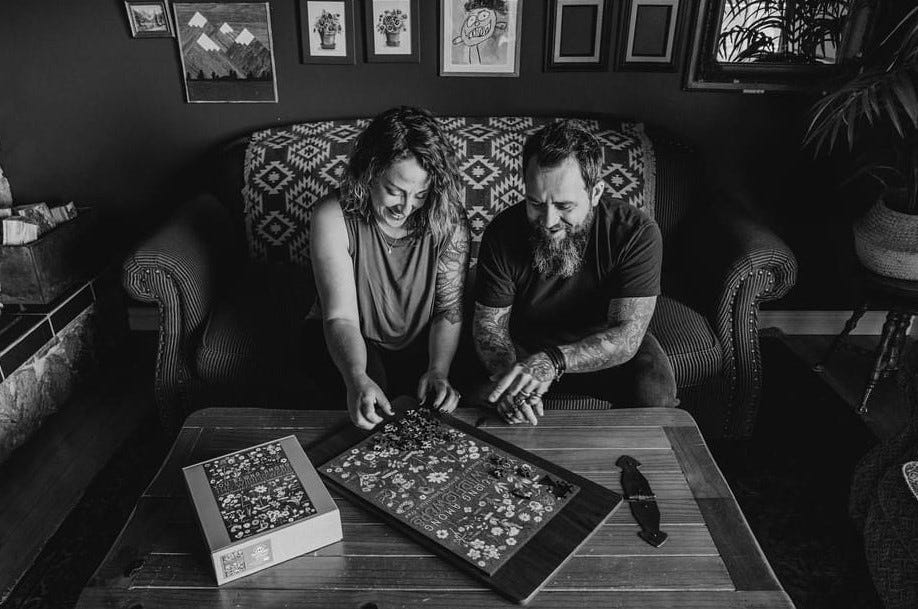
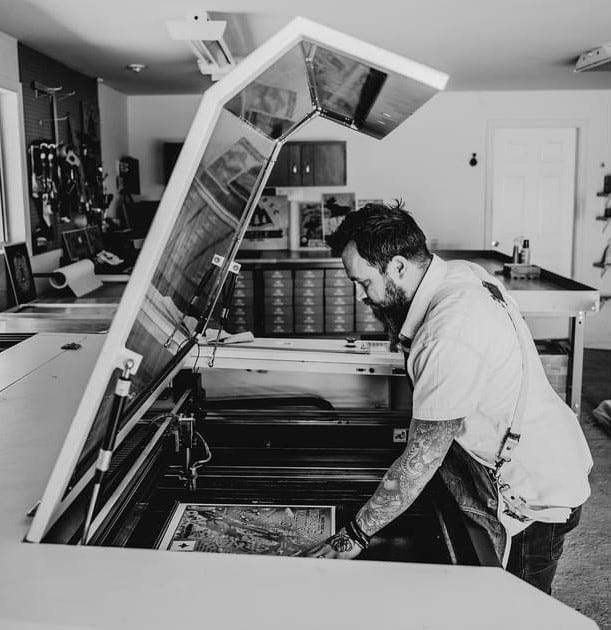

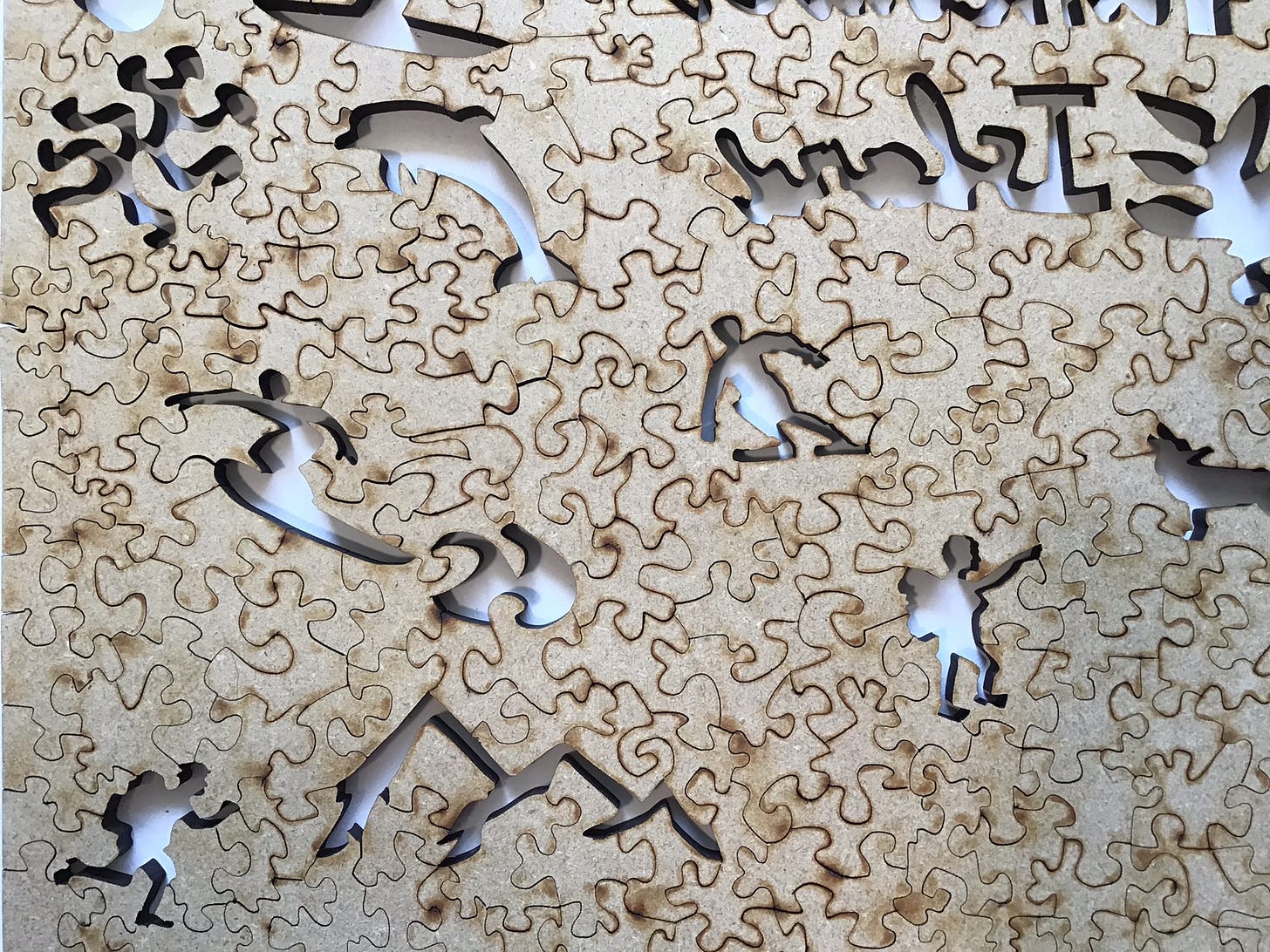
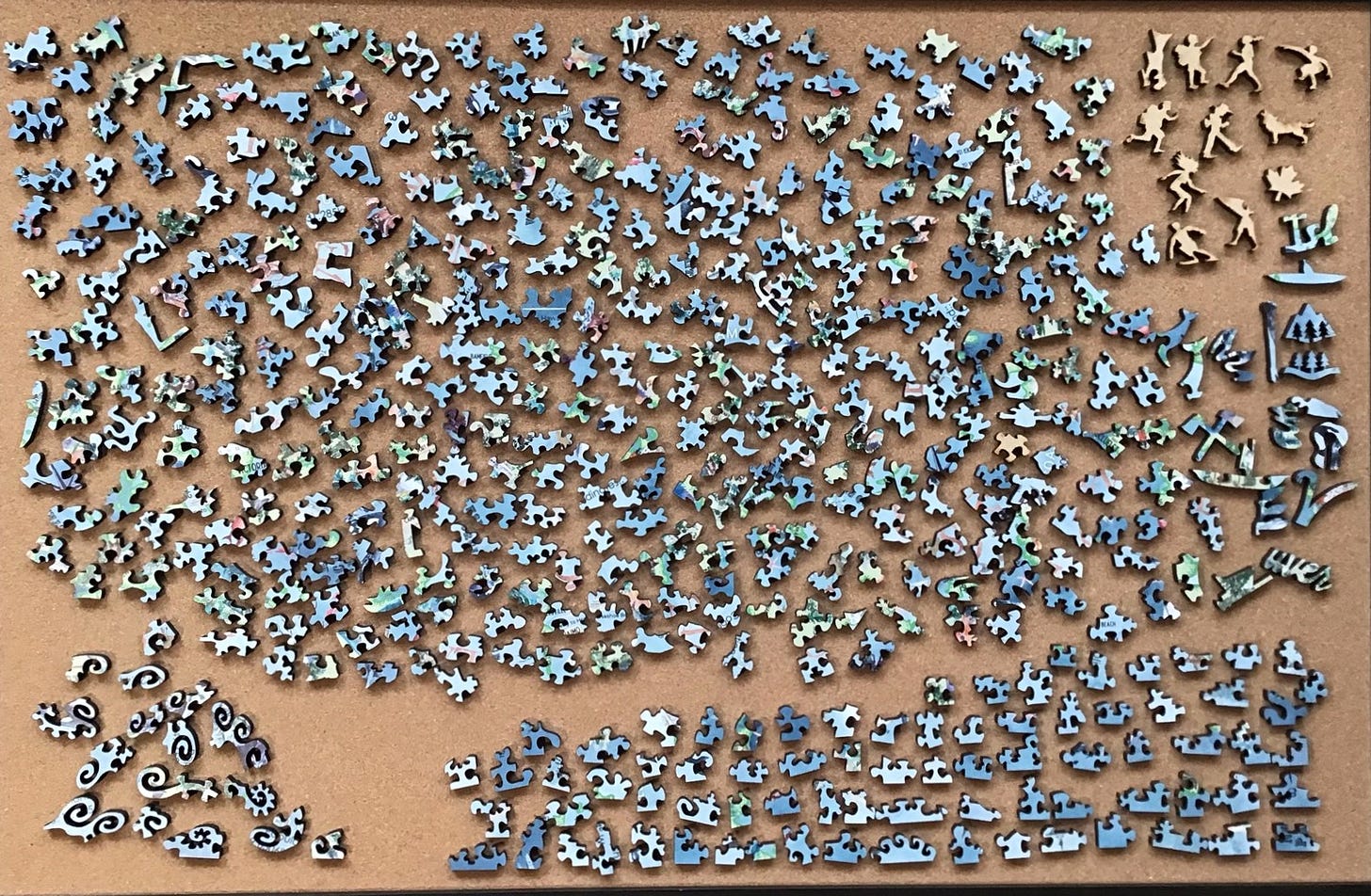
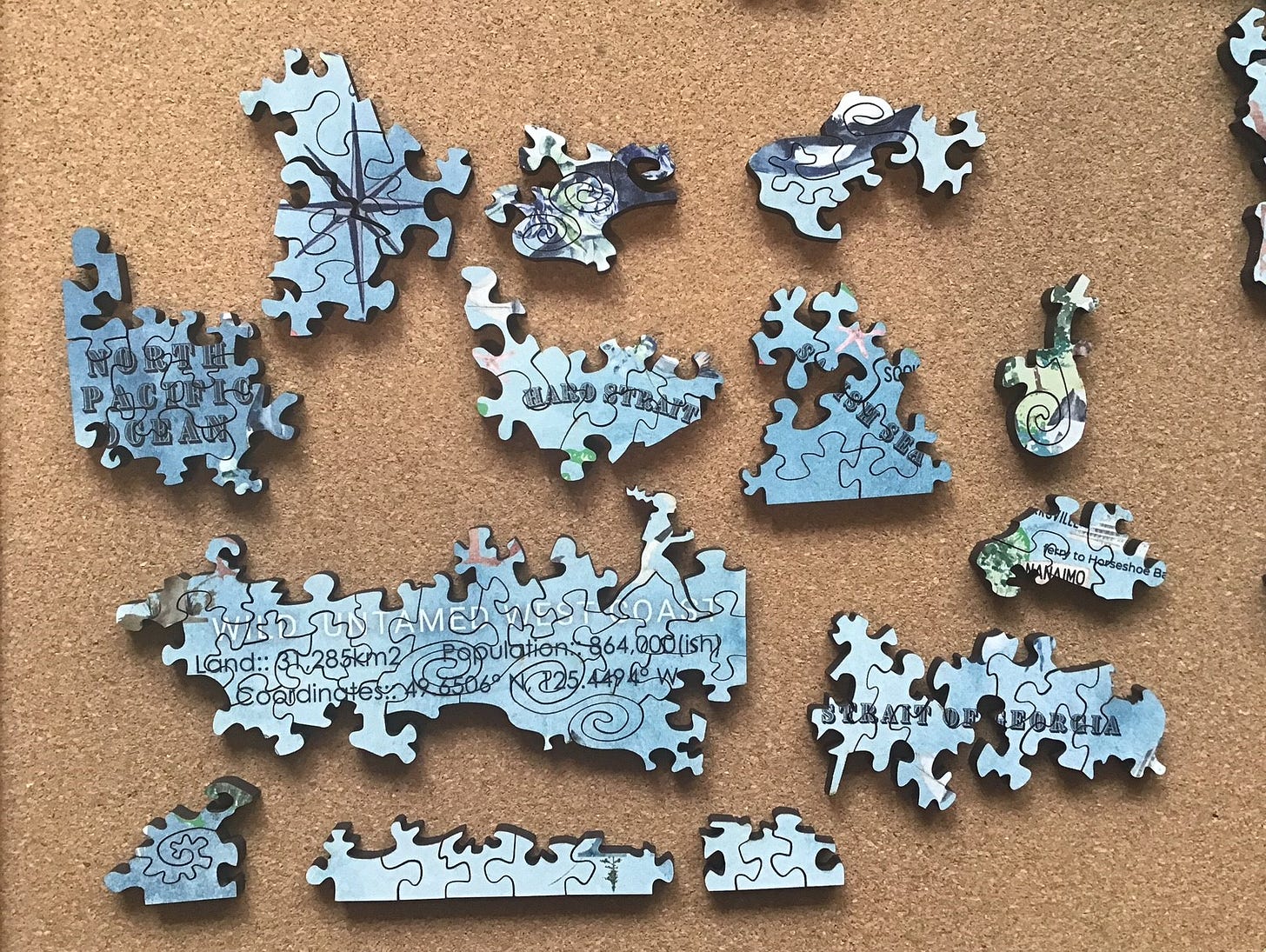

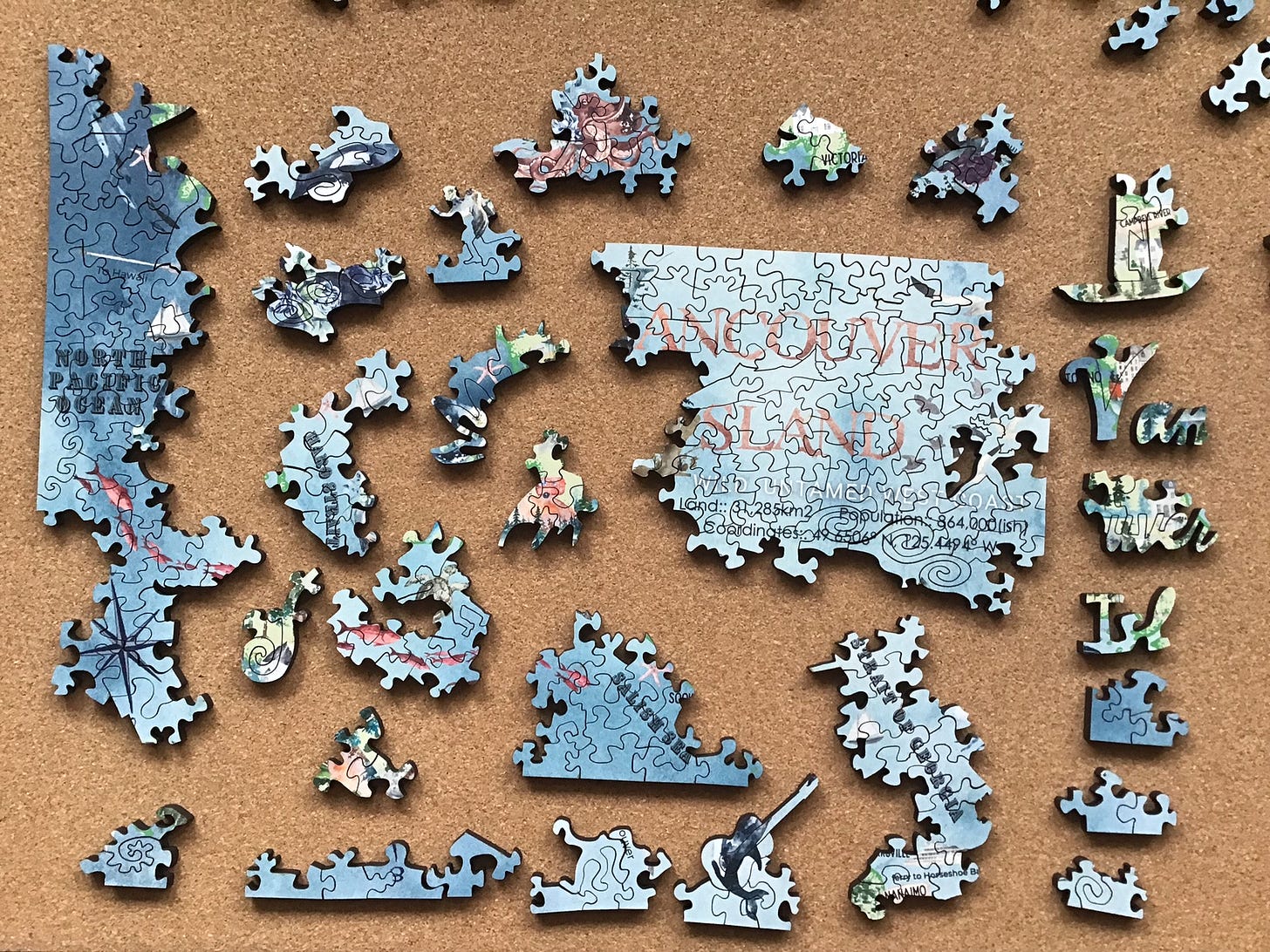
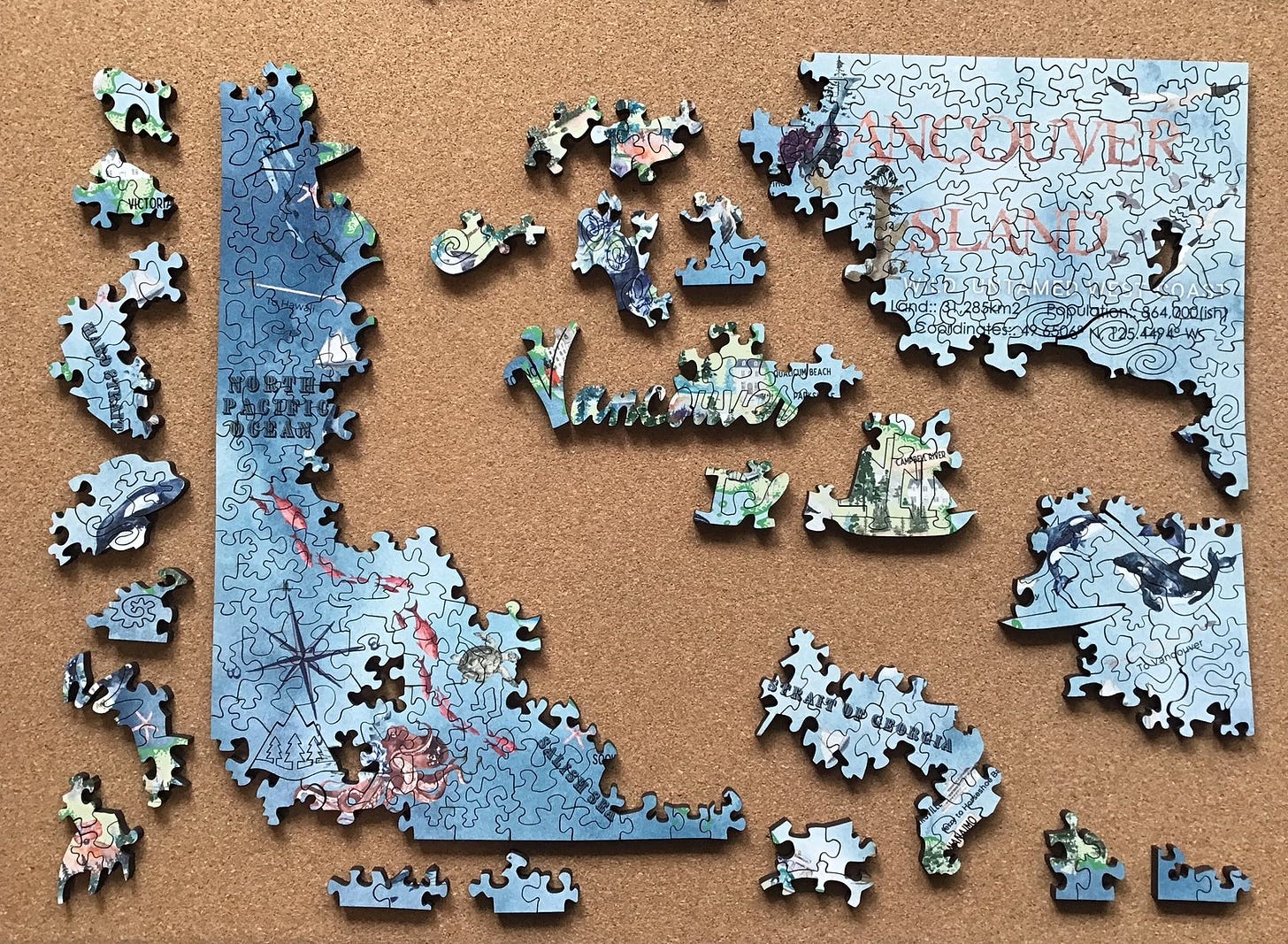
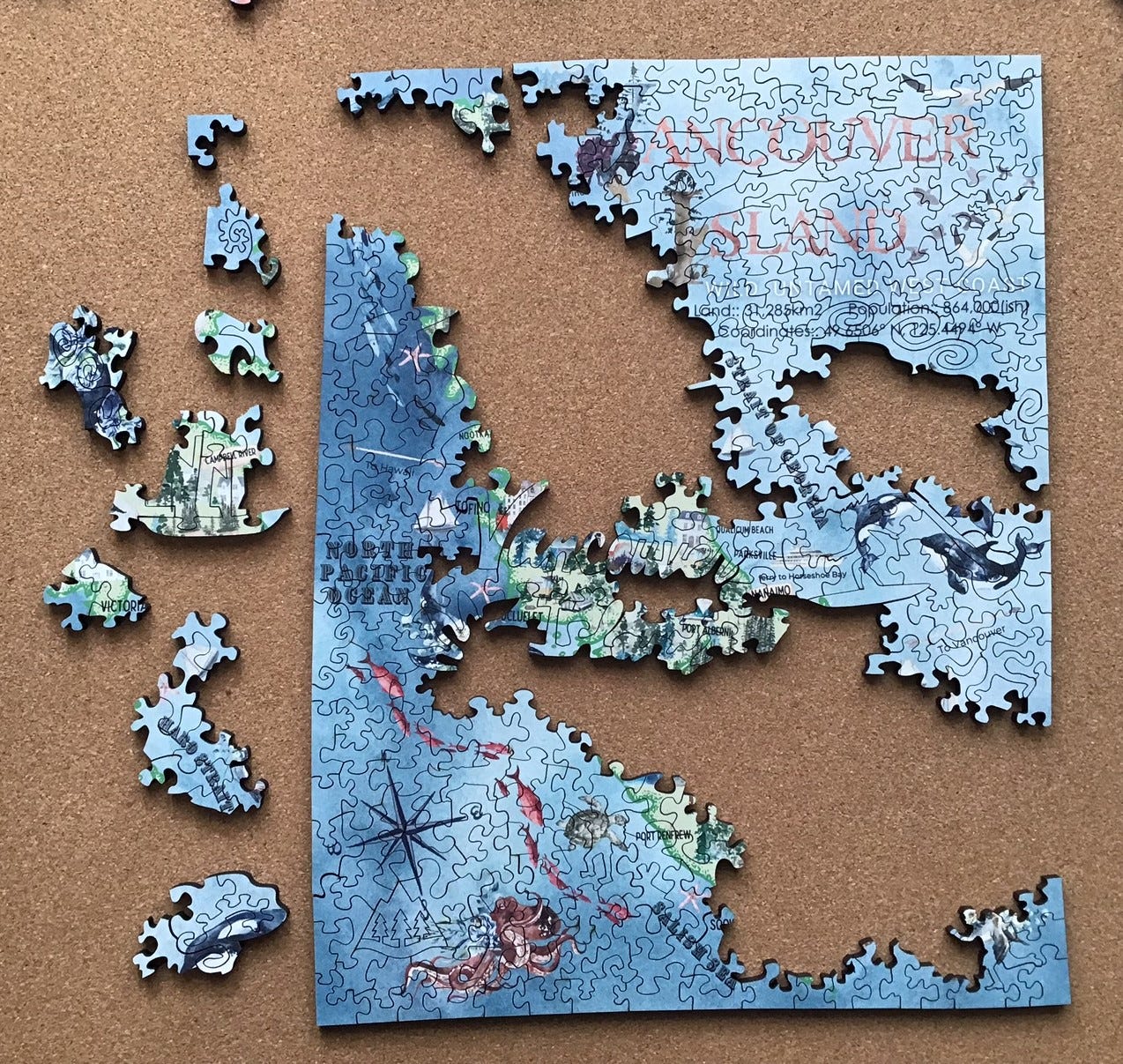

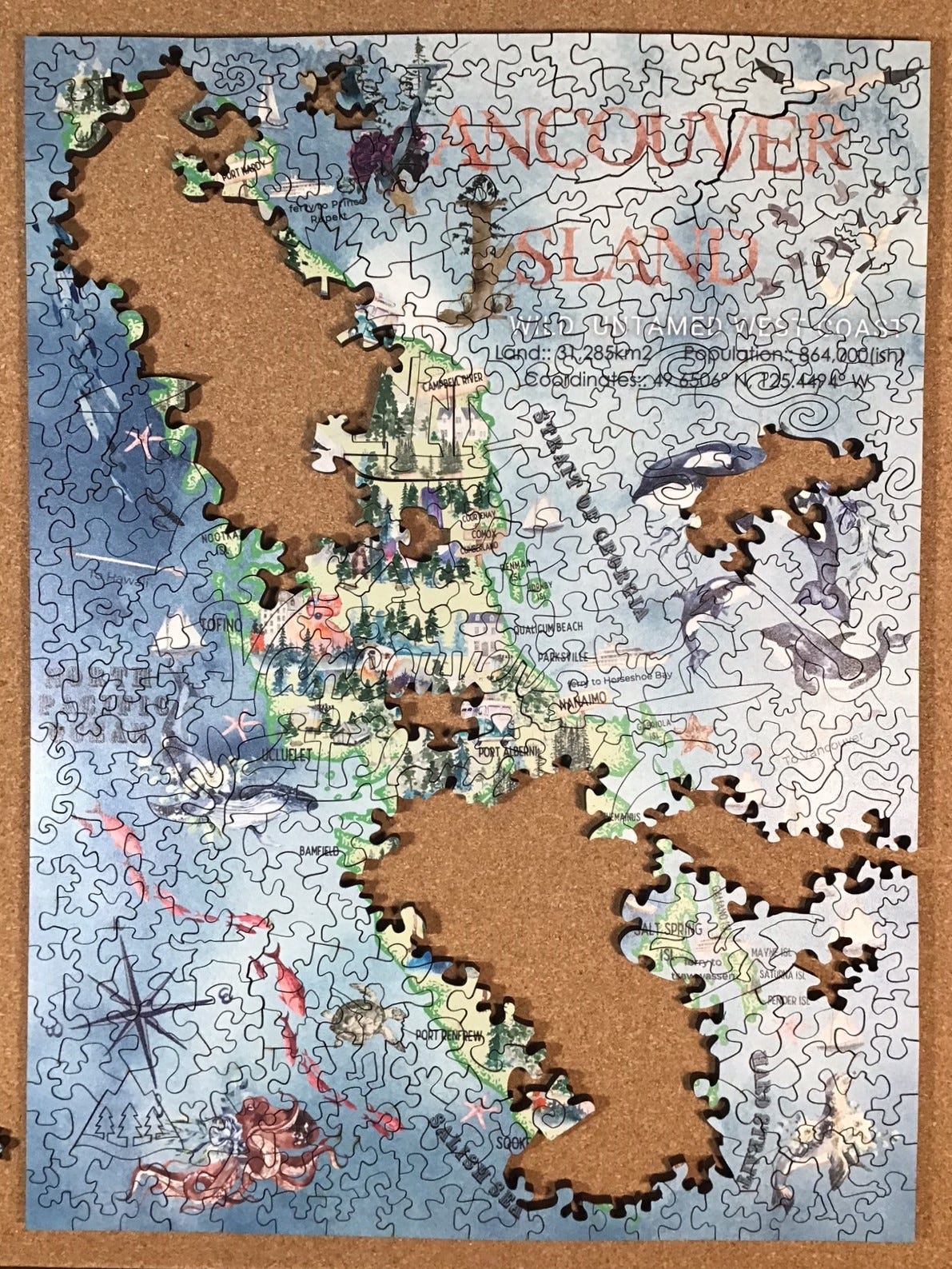
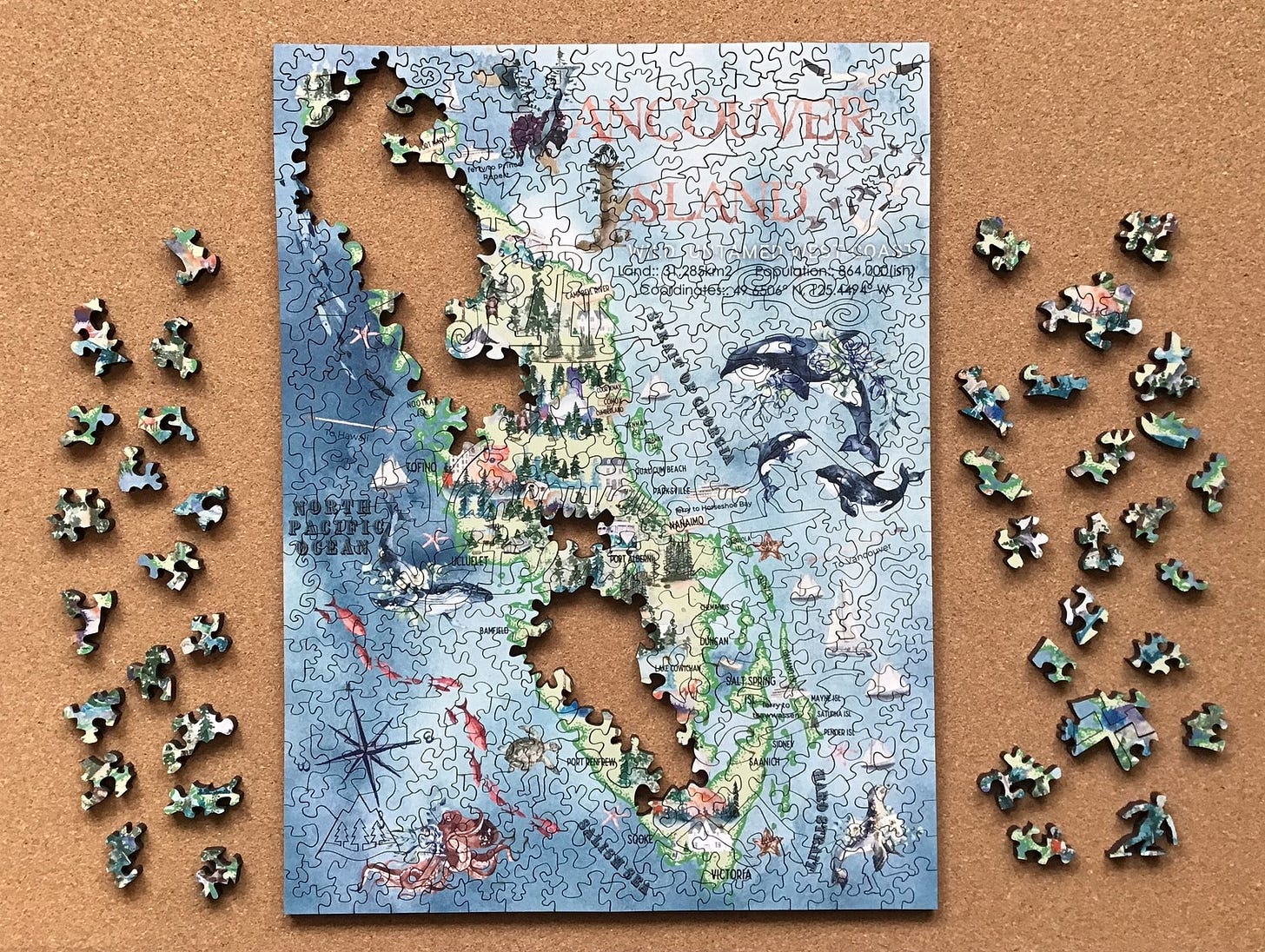
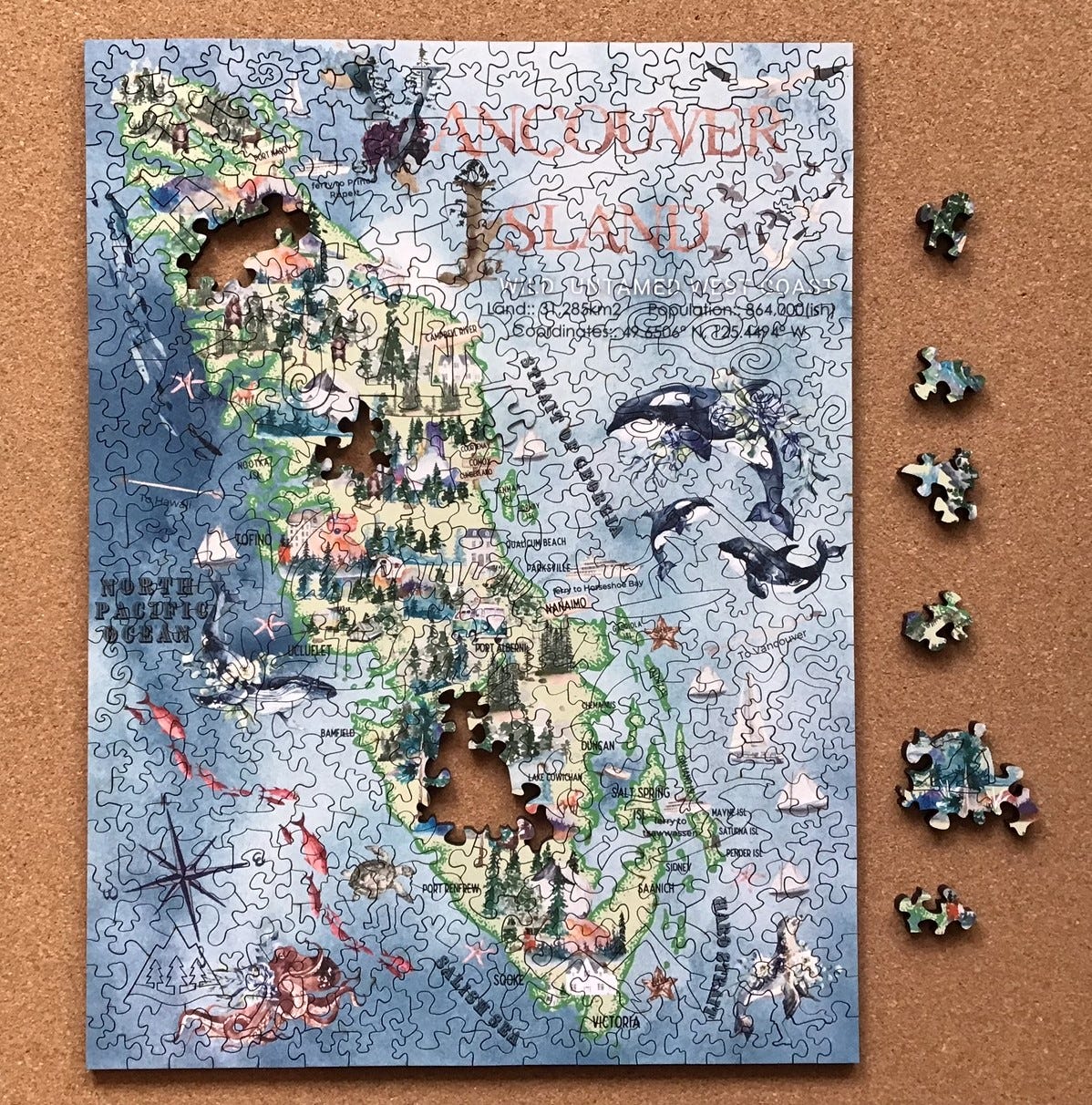
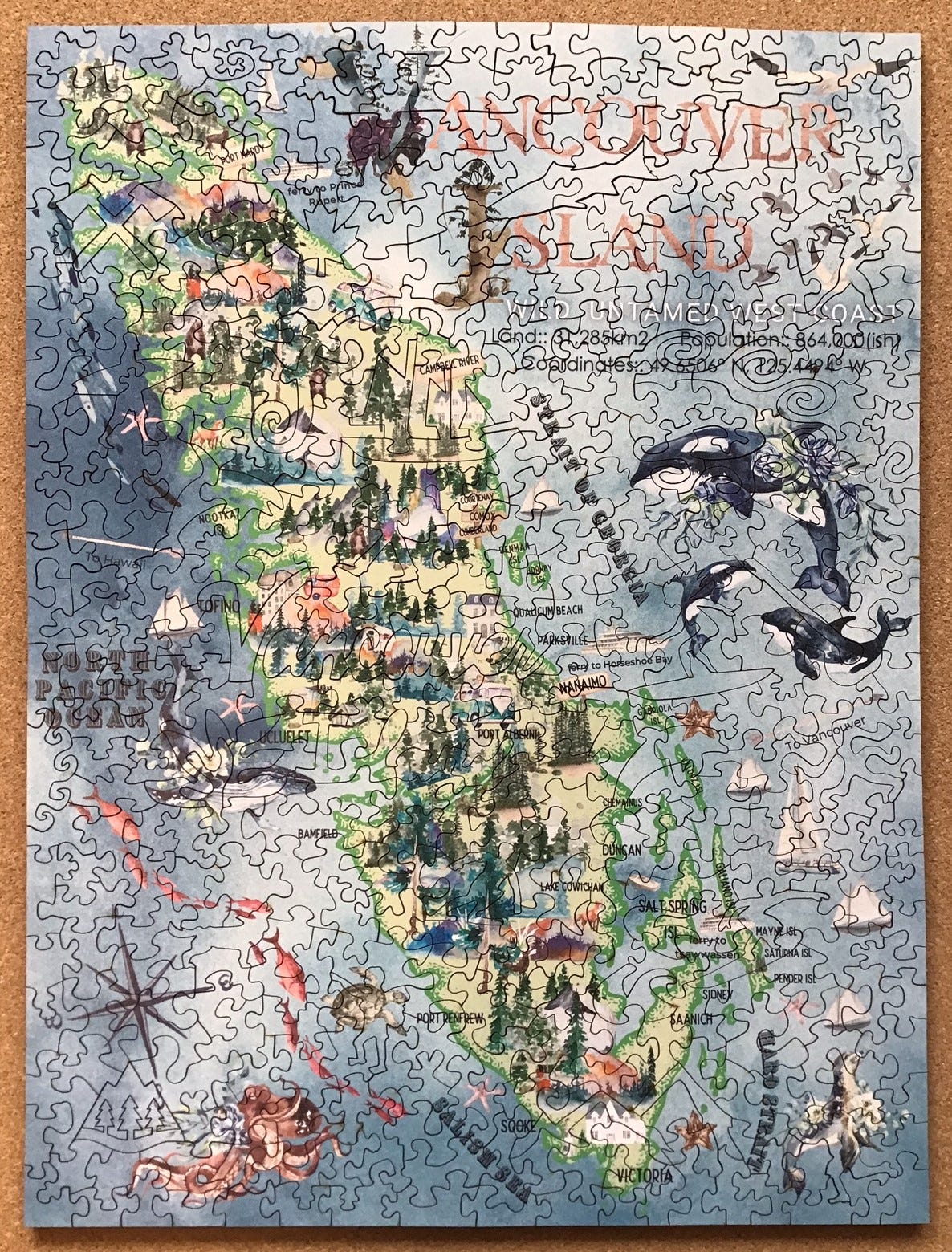


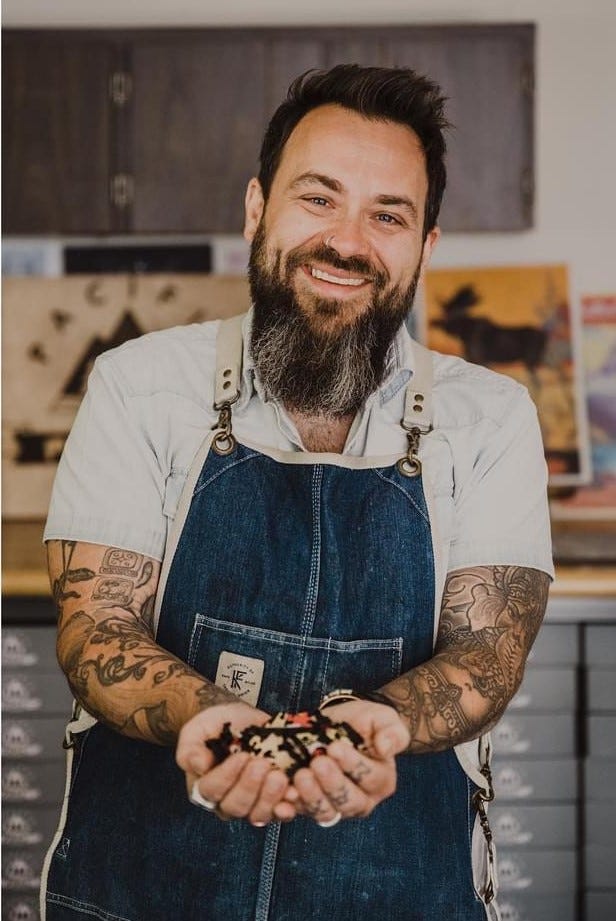
This is a fine posting today, Bill. Your opening paragraphs do resonate for me with what I recall about your earlier "trial" purchase from, and comments about, the Pacific Puzzle Co. I am pleased to read that their pictures may "grow on one," and also that they've corrected the earlier smudging issue. As you say, it is gratifying to support local companies when they deserve our support. I really like the account of the founding of this particular company and its founders' values. I know many folks, including me, can identify with "falling in love with the peace and quiet of puzzle time."
I agree with you, Bill, that Vancouver Island's mountains belonged in the depiction of our island. It looks like the mountains did get included in the clever and locally relevant set of figural pieces. Something else that occurs to me is that I'd like to see an additional map-based puzzle created that would show all of our eco-region, the beautiful larger area of Cascadia, which includes watersheds and connected lands that share common features both above and below the 49th Parallel.
The photos of Kat and Aaron that you've included are engaging and appealing. I wish this couple well with their work.
One last thing I'd like to say is that I appreciate your giving "spoiler alerts," though I don't personally mind seeing detailed previews. I think the way you've shown us ten images of the gradually more-and-more complete puzzle picture, leading up to the final complete picture, has actually allowed me to share in the feeling you describe of having grown to like the puzzle picture by increments.
Cheers,
Greg
It looked like what you wrote required a lot of time and thought! Well done.
—Greg